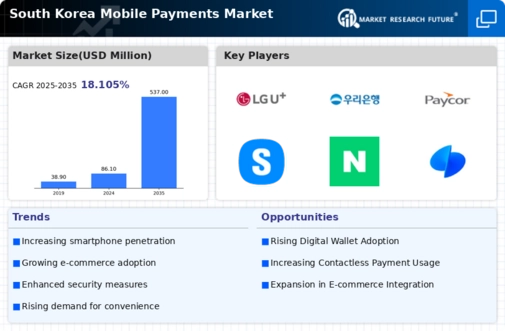Government Initiatives and Support
Government initiatives play a crucial role in shaping the mobile payments market in South Korea. The South Korean government has implemented various policies aimed at promoting digital financial services, including tax incentives for fintech companies and investments in digital infrastructure. These efforts have led to a notable increase in the adoption of mobile payment solutions, with the market projected to reach $100 billion by 2026. Furthermore, regulatory frameworks are being established to ensure consumer protection and data security, which enhances trust in the mobile payments market. Such supportive measures are likely to foster innovation and competition among service providers.
Rise of E-commerce and Online Shopping
The rise of e-commerce and online shopping has been a pivotal driver for the mobile payments market in South Korea. With the increasing popularity of online retail platforms, consumers are seeking convenient payment options that mobile payments provide. As of 2025, e-commerce sales in South Korea are projected to exceed $150 billion, with a significant portion of these transactions being conducted via mobile payment solutions. This trend indicates a strong correlation between the growth of online shopping and the mobile payments market, as businesses are increasingly integrating mobile payment options to enhance customer experience and streamline checkout processes.
Enhanced Security Features and Consumer Trust
Enhanced security features are becoming increasingly vital in the mobile payments market, as consumer trust is paramount for widespread adoption. In South Korea, advancements in biometric authentication, such as fingerprint and facial recognition, are being integrated into mobile payment systems. These features not only provide a secure transaction environment but also alleviate consumer concerns regarding fraud and data breaches. As a result, the mobile payments market is witnessing a rise in user confidence, with studies indicating that 75% of consumers feel more secure using mobile payments due to these innovations. This growing trust is likely to drive further adoption and usage of mobile payment solutions.
Technological Advancements in Payment Systems
The mobile payments market in South Korea is experiencing a surge due to rapid technological advancements in payment systems. Innovations such as Near Field Communication (NFC) and QR code scanning have streamlined transaction processes, making them faster and more efficient. As of 2025, approximately 70% of South Korean consumers utilize mobile payment solutions, reflecting a growing preference for digital transactions. This trend is further supported by the increasing penetration of smartphones, with over 95% of the population owning a mobile device. The mobile payments market is thus poised for continued growth as technology evolves, enabling more seamless and user-friendly payment experiences.
Consumer Behavior Shifts Towards Digital Solutions
There is a marked shift in consumer behavior towards digital solutions in South Korea, significantly impacting the mobile payments market. A growing number of consumers prefer the convenience and speed of mobile payments over traditional cash transactions. Recent surveys indicate that nearly 60% of South Koreans have adopted mobile payment methods for everyday purchases, reflecting a cultural shift towards embracing technology in financial transactions. This trend is further amplified by the younger demographic, who are more inclined to use mobile wallets and payment apps. The mobile payments market is thus adapting to these changing preferences, leading to increased competition among providers.





















Leave a Comment